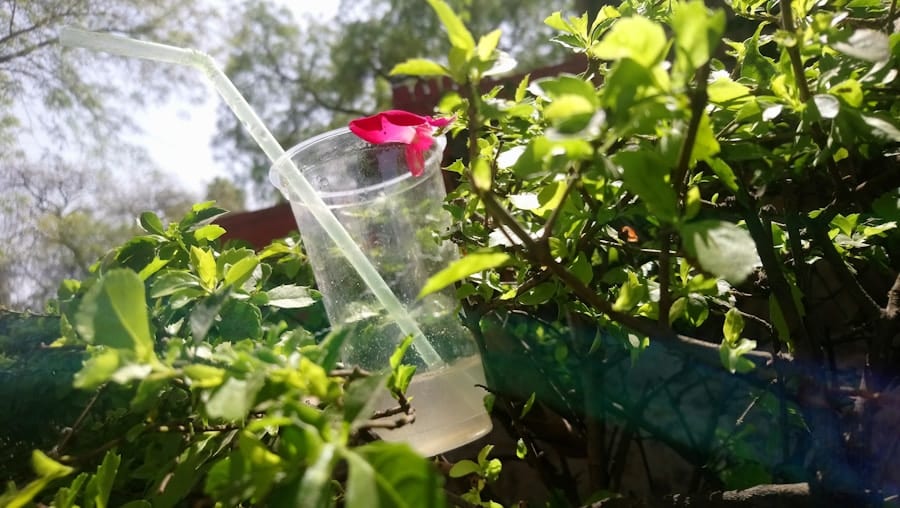The intersection of artificial intelligence (AI) and sustainable materials science is becoming increasingly significant in addressing the global plastic crisis. As the world grapples with the environmental repercussions of traditional plastics, which can take hundreds of years to decompose, the need for innovative solutions has never been more urgent. Sustainable plastics, particularly biodegradable options, offer a promising avenue for reducing plastic waste and mitigating its harmful effects on ecosystems.
The integration of AI into this field is poised to revolutionize the development and production of these materials, enhancing their efficiency, performance, and environmental compatibility. AI technologies, including machine learning and data analytics, are being harnessed to optimize the design and synthesis of biodegradable plastics. By analyzing vast datasets related to material properties, degradation rates, and environmental interactions, AI can identify novel compounds and formulations that traditional methods might overlook.
This synergy between AI and sustainable plastics not only accelerates the research and development process but also enables a more targeted approach to creating materials that meet both consumer needs and environmental standards. As we delve deeper into the challenges and innovations in this field, it becomes clear that AI is not just a tool but a transformative force in the quest for sustainable solutions.
Key Takeaways
- AI is playing a crucial role in advancing the development of sustainable and biodegradable plastics, addressing the environmental concerns associated with traditional plastics.
- Current challenges in developing biodegradable plastics include cost-effectiveness, scalability, and performance compared to traditional plastics.
- AI is revolutionizing material science by accelerating the discovery and development of biodegradable plastics with improved properties and performance.
- AI-driven innovations in material science are leading to the creation of sustainable plastics that can reduce environmental impact and offer various benefits.
- The future of AI-driven sustainable plastics holds great potential for applications across industries and markets, but ethical and regulatory considerations must be carefully addressed to ensure responsible development and use.
Current Challenges in Developing Biodegradable Plastics
Performance Gap
One of the primary issues is the performance of these materials compared to conventional plastics. Many biodegradable options do not possess the same mechanical strength or durability, which limits their applicability in various industries. For instance, while polylactic acid (PLA) is a popular biodegradable alternative, it often falls short in terms of heat resistance and moisture barrier properties when compared to polyethylene or polypropylene.
Sustainability Concerns
Another significant challenge lies in the production processes associated with biodegradable plastics. Many of these materials are derived from renewable resources such as corn starch or sugarcane, which raises concerns about land use and food supply. The cultivation of these crops for plastic production can compete with food production, leading to potential food shortages or increased prices.
The Role of AI in Advancing Biodegradable Plastics

AI plays a pivotal role in overcoming the challenges associated with developing biodegradable plastics by streamlining research and enhancing material design. Machine learning algorithms can analyze existing data on polymer properties and degradation behaviors to predict how new formulations will perform under various environmental conditions. This predictive capability allows researchers to focus their efforts on the most promising candidates for further development, significantly reducing the time and resources required for material innovation.
Moreover, AI can facilitate the optimization of production processes for biodegradable plastics. By employing advanced analytics and real-time monitoring systems, manufacturers can fine-tune their operations to minimize waste and energy consumption. For example, AI-driven process control systems can adjust parameters such as temperature and pressure during polymerization to ensure consistent quality while reducing the carbon footprint of production.
This level of precision not only enhances the sustainability of biodegradable plastics but also makes them more competitive with traditional materials in terms of cost and performance.
AI-Driven Innovations in Material Science for Sustainable Plastics
The application of AI in material science has led to groundbreaking innovations in the development of sustainable plastics. One notable example is the use of generative design algorithms, which can create novel polymer structures by simulating various molecular configurations and their interactions. These algorithms can identify unique combinations of monomers that yield biodegradable plastics with enhanced properties, such as improved tensile strength or faster degradation rates.
This approach allows researchers to explore a vast design space that would be impractical through traditional trial-and-error methods. Additionally, AI can assist in the discovery of bio-based additives that enhance the performance of biodegradable plastics. For instance, researchers are exploring natural fibers or biopolymers that can be incorporated into plastic formulations to improve their mechanical properties while maintaining biodegradability.
By leveraging AI to analyze the compatibility and performance of these additives, scientists can develop composite materials that meet specific industry requirements without relying on harmful synthetic additives. This innovation not only contributes to the sustainability of plastic products but also opens new avenues for recycling and circular economy practices.
Environmental Impact and Benefits of AI-Driven Biodegradable Plastics
The environmental impact of AI-driven biodegradable plastics is profound, offering a pathway toward reducing plastic pollution and its associated ecological consequences. Traditional plastics contribute significantly to landfills and oceans, where they can harm wildlife and disrupt ecosystems. In contrast, biodegradable plastics are designed to break down into non-toxic components under specific conditions, thereby minimizing their long-term environmental footprint.
The integration of AI in their development enhances this benefit by enabling the creation of materials that degrade more efficiently and predictably. Furthermore, AI-driven innovations can lead to biodegradable plastics that are tailored for specific applications, ensuring that they perform effectively while still being environmentally friendly. For example, packaging materials designed with AI insights can be engineered to decompose within a certain timeframe after use, reducing litter and waste accumulation.
This targeted approach not only addresses consumer demands for sustainable products but also aligns with regulatory pressures aimed at reducing single-use plastics. As these materials gain traction in various sectors, their positive environmental impact could significantly contribute to global sustainability goals.
Future Applications and Market Potential of AI-Driven Sustainable Plastics

The future applications of AI-driven sustainable plastics are vast and varied, spanning multiple industries from packaging to automotive manufacturing. In the packaging sector, companies are increasingly seeking alternatives to conventional plastic wraps and containers that contribute to waste accumulation. AI-driven biodegradable films that maintain freshness while decomposing after use could revolutionize food packaging, providing an eco-friendly solution that meets consumer expectations for sustainability.
In addition to packaging, the automotive industry presents significant opportunities for integrating biodegradable plastics into vehicle components. As manufacturers strive to reduce their carbon footprints, lightweight biodegradable materials could replace traditional plastics in non-structural parts such as interior panels or insulation. The use of AI in optimizing these materials for strength and durability could lead to vehicles that are not only lighter but also more environmentally responsible throughout their lifecycle.
The market potential for AI-driven sustainable plastics is substantial as consumer awareness regarding environmental issues continues to rise. Companies that invest in developing these innovative materials stand to gain a competitive edge in an increasingly eco-conscious marketplace. Furthermore, as regulations around plastic use tighten globally, businesses that adopt sustainable practices early on will likely benefit from favorable public perception and potential financial incentives.
Ethical and Regulatory Considerations in AI-Driven Sustainable Plastics
As with any technological advancement, the integration of AI into the development of sustainable plastics raises ethical and regulatory considerations that must be addressed. One primary concern is ensuring that the production processes for biodegradable plastics do not inadvertently harm ecosystems or communities. For instance, sourcing raw materials from agricultural practices that deplete soil health or contribute to deforestation poses ethical dilemmas that require careful management.
Policymakers must establish guidelines that ensure these materials are genuinely biodegradable under real-world conditions rather than merely under laboratory settings. This includes defining standards for biodegradability and compostability that manufacturers must adhere to before products can be marketed as environmentally friendly.
Additionally, transparency in labeling practices will be crucial to help consumers make informed choices about the products they purchase.
The Promising Future of AI in Developing Sustainable, Biodegradable Plastics
The future of AI in developing sustainable, biodegradable plastics is filled with promise as technological advancements continue to unfold. By harnessing the power of artificial intelligence, researchers and manufacturers can overcome existing challenges related to performance, production efficiency, and environmental impact. The potential applications across various industries highlight a transformative shift toward more responsible material usage that aligns with global sustainability goals.
As society increasingly prioritizes environmental stewardship, the role of AI in creating innovative solutions will be paramount in shaping a more sustainable future. The collaboration between technology and material science not only paves the way for new products but also fosters a deeper understanding of our relationship with plastic consumption and waste management. With continued investment in research and development, AI-driven biodegradable plastics could become a cornerstone of a circular economy where materials are designed for longevity while minimizing ecological harm.
In a related article discussing the importance of user experience in software development, the best software for UX is highlighted as a crucial factor in creating sustainable, biodegradable plastics. By utilizing user-friendly software, developers can streamline the process of designing and producing eco-friendly materials. This article emphasizes the role of technology in advancing sustainability efforts across various industries, including the creation of biodegradable plastics.
FAQs
What is AI?
AI, or artificial intelligence, refers to the simulation of human intelligence in machines that are programmed to think and act like humans. This includes tasks such as learning, problem-solving, and decision-making.
What are sustainable, biodegradable plastics?
Sustainable, biodegradable plastics are materials that are designed to break down and decompose naturally in the environment, reducing the amount of plastic waste that ends up in landfills and oceans. These plastics are made from renewable resources and are environmentally friendly.
How is AI being used in the development of sustainable, biodegradable plastics?
AI is being used to improve the efficiency and effectiveness of the development process for sustainable, biodegradable plastics. This includes tasks such as material design, process optimization, and predictive modeling to create plastics that are both sustainable and biodegradable.
What are the benefits of using AI in the development of sustainable, biodegradable plastics?
Using AI in the development of sustainable, biodegradable plastics can lead to faster and more accurate results, reduced costs, and the ability to explore a wider range of potential materials and processes. This can ultimately lead to the creation of more environmentally friendly plastics.
What are some challenges in using AI for sustainable, biodegradable plastics?
Challenges in using AI for sustainable, biodegradable plastics include the need for large amounts of data for training AI models, the complexity of material design and process optimization, and the need for interdisciplinary collaboration between AI experts and materials scientists.

